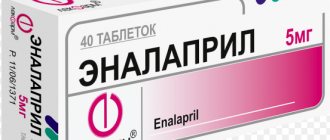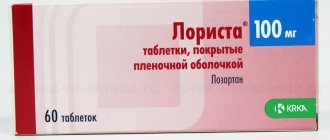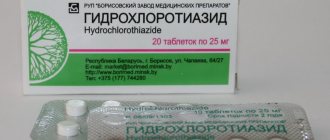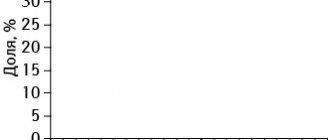Diuretics, or, as they are also called, diuretics, are a group of drugs that are not homogeneous in their chemical composition. These drugs remove water and minerals from the human body through the kidneys.
We present to your attention a list of those diuretics that are most often used in modern medicine, as well as their characteristics and classification.
Potassium-sparing diuretics
A potassium-sparing diuretic is a diuretic that regulates the release of potassium ions, minimizing their loss in urine, and also increases the secretion of sodium and chlorine in the nephrons. There are two main types of such drugs: aldosterone antagonists and distal tubular potassium excretion inhibitors. They have different mechanisms of action.
This subtype of diuretic drugs differs from classical diuretics in several factors:
- have a less pronounced effect;
- The patient does not see the effect of the medications immediately - it occurs after 10-12 hours or the next day;
- They are rarely used as separate agents for therapy; more often they are auxiliary components of complex treatment.
Which brand of diuretic is best to choose?
The first criterion by which you can choose a safe diuretic with the desired therapeutic effect is a manufacturer with an impeccable reputation, successful activities and a good range of products. Recommendations from medical specialists and real reviews helped identify worthy nominees. The following companies were included in the review:
- Kanonpharma Production (Torasemide) is a modern Russian pharmaceutical company founded in 1998. In a short period of work, a production base has already been created according to the latest innovations and international standards.
- Obolenskoye Pharmaceutical Enterprise (Spironolactone) is a Russian pharmaceutical company founded in 1994. The base of the State Center for Applied Microbiology contributed to the emergence and development. The range of modern drugs fully complies with ISO and GMP standards.
- Sopharma (Furosemide) is a private manufacturer from Bulgaria, which has been improving the quality of human life for over 80 years. In 1933, pharmacists united and created their own laboratory; since then, technologies have been regularly updated, creating natural, effective medicines.
- Quinoine Rt. (Hypothiazide) is a plant of pharmaceutical and chemical products, as well as a subsidiary of Sanofi-Synthelabo from Hungary. It has two factories, one produces products in the form of tablets and capsules, the other produces solutions for injections or in bottles.
- Gedeon Richter-Rus (Veroshpiron) is an international corporation that produces medicines in more than 100 countries. But the main office is registered in Hungary. For over 115 years, the brand has been providing clinics and their patients with high-quality, effective treatment.
- Pharmapol-Volga (Asparkam) is a Russian pharmaceutical company engaged in the production of finished medicines and substances, medical products since 1998.
- Hemofarm (Indapamide) is an international pharmaceutical company that was founded in Serbia in 1960. And since 2006, it has been privatized by the famous German company Stada Ag.
- OZONE (Hydrochlorothiazide) is one of the leading Russian companies producing medicines for various fields of medicine. Among domestic pharmaceutical companies, it stands out with its huge competitive generic portfolio.
- Ratiopharm (Amiloride) is a German company that has become famous for producing effective but inexpensive generics of world bestsellers in the pharmaceutical field. Founded in 1974. The product range is distributed not only within Germany, but also in 35 countries around the world.
- LLC Grotex (Eufillin) is a well-known Russian pharmaceutical company that produces sterile liquid medicines. All products comply with GMP standards.
- Herbapol (Phytolysin) is a Wroclaw-based herbal company offering natural treatments for various diseases. It is the largest Polish manufacturer of natural products, operating for over 60 years.
- Bionorica SE (Canephron) is a global manufacturer of exclusively herbal preparations, which has been in this business for over 80 years. Products are registered in more than 40 countries.
Indications for use
There is a list of indications when the use of potassium-sparing diuretics is justified:
- treatment of hypokalemia (used in combination with other medications);
- complex therapy of hypertension;
- diabetes mellitus of the first and second types (since with excessive urination the patient loses a lot of potassium ions);
- primary or secondary hyperaldosteronism;
- heart failure, myocardial pathology;
- gout;
- the use of cardiac glycosides (potassium-sparing agents enhance their effect);
- severe chronic swelling caused by excess sodium, chlorine or disruption of the lymphatic system.
Taking potassium-sparing diuretics is also necessary in other cases. They are prescribed when the patient, for some reason, is already taking drugs that actively remove potassium from the body, for example, carbonic anhydrase.
The most common
- Spironolactone.
This is a potassium-sparing and magnesium-sparing diuretic drug; it is an aldosterone antagonist. The active ingredient is spironolactone. Spironolactone is used individually and prescribed by a doctor. As a rule, for edema, 100 to 200 mg per day is prescribed, and this dose must be divided into 2-3 times. This dosage is prescribed for 14-21 days. The course can be repeated after 10 days.- Can be taken by pregnant women, but in the 2nd and 3rd trimester. During breastfeeding, it can also be taken, only taking into account that the active substance will pass into the milk in a minimal amount.
- The cost of Spironolactone in the form of tablets 25 mg No. 30 is 297 rubles.
A dose of 300 mg per day can be prescribed for the treatment of hyperaldosteronism and in cases where the analysis showed a reduced potassium content in plasma. The dosage is divided into 2-3 doses.
This drug belongs to the potassium- and magnesium-sparing diuretics and aldosterone antagonists. The active ingredient is spironolactone. Prescribed 100-200 mg in 2-3 doses, when they are combined with other types of diuretics (loop, thiazide). An amount of 300 mg is prescribed if there is severe hyperaldosteronism, as well as with a decrease in potassium in the plasma; this dose should also be divided into 2-3 doses.
It is contraindicated to use during the 1st trimester of pregnancy; as for the 2nd and 3rd, this is possible, but only as prescribed by a doctor. It can also be used during lactation, but the active substance will pass into milk in minimal quantities.
This is a potassium-sparing diuretic, which is an aldosterone antagonist (long-acting). The effect of taking a diuretic appears on days 2-5 of therapy. The active ingredient is spironolactone.
Prescribed for essential hypertension from 50 to 100 mg per day, taken once. For hyperaldosteronism, 100 to 400 mg can be prescribed, depending on individual characteristics. If edema appears in chronic heart failure, 100 to 200 mg per day is prescribed, and the drug is combined with other types of diuretics.
Triampur is a combination diuretic, that is, it contains triamterene (a potassium-sparing substance) and hydrochlorothiazide (a thiazide diuretic). It is prescribed for arterial hypertension 2 times, 2 tablets, but if the treatment is long-term, then 2 tablets are prescribed per day. The initial dose for edema is 1 to 2 tablets 2 times. Maintenance therapy is also prescribed, the dosage is 1 tablet per day or 2 tablets every other day. For complex treatment of heart failure, 2 tablets per day can be prescribed, the maximum dose is 4 tablets. But the individual testimony of the patient is quite important.
If renal failure develops, it is not recommended to take more than 1 tablet per day. It is prohibited to take the drug during pregnancy and lactation. If necessary, stop feeding.
Author of the article:
Elena Demidova
about the author
Did you like the article?
Let us know about it -
rate
Side effects
Although this group of diuretics is inferior in potency to “classical” diuretics, in large doses or with long-term use they can give unwanted side effects:
- manifestations of urolithiasis (due to increased excretion of sodium);
- increased sensitivity of the eyes to light;
- digestive disorders (in the form of nausea, vomiting, stomach pain, diarrhea or constipation);
- night muscle cramps;
- headaches, dizziness, sleep disturbances;
- hyperkalemia.
If such symptoms and conditions occur, the patient should stop taking the diuretic and consult a doctor. If the patient needs to constantly drink diuretics, the specialist will select a different type of drug. When there is no urgent need for this, they take a break from therapy.
Contraindications
Most people are able to take potassium-sparing diuretics. However, there are certain contraindications to taking these drugs, namely:
- High levels of potassium in the blood (hyperkalemia);
- Renal damage, renal failure (increases the risk of developing hyperkalemia);
- It is undesirable to combine them with ACE inhibitors in elderly patients (read more about the reasons in the section other diuretics below);
- Addison's disease.
Types of potassium-sparing drugs
Diuretics that conserve potassium in the body are divided into two types:
- competitive aldosterone receptor antagonists;
- inhibitors of tubular secretion of potassium ions in the distal tubules of nephrons.
The first group of drugs has a competitive mechanism of action. The main substance of the drug has a similar molecular structure to aldosterone, a hormone that enhances the reabsorption of sodium. This is necessary to reduce salt loss and raise blood pressure. The antagonist agent binds to aldosterone receptors, blocking them, and the real biologically active molecule can no longer bind to them. The body begins to excrete more sodium, and the body retains potassium and calcium.
Competitive aldosterone antagonists should not be taken for too long, as they reduce sensitivity to the hormone, and this can disrupt mineral metabolism.
Diuretics of another generation - inhibitors of tubular secretion of potassium in the distal tubules - produce an effect by acting on the body in a slightly different way. They regulate the functioning of the sodium-potassium pump, enhancing the reuptake of molecules of the second element.
Separately, it is worth saying that aldosterone antagonists are used not only for their diuretic effect. They are often prescribed for increased secretion of mineralcorticoid in the adrenal cortex. In such cases, the patient’s body is less able to remove excess water molecules, and this negatively affects the functioning of the kidneys and heart and increases swelling, especially in the lower extremities.
The best diuretics
The formation of edema can be triggered by various diseases that affect the kidneys, heart, lungs, liver, blood vessels; it can also be the consequences of allergic reactions, pregnancy, excessive consumption of water and other abnormalities. The best diuretics, selected by Top experts based on doctors’ recommendations, patient reviews, and clinical trials, can quickly and effectively solve the problem. How to choose which of those offered to buy will be determined by the correct criteria, the reputation of the pharmaceutical company of the manufacturer, as well as the proposed circumstances requiring the use of such drugs.
Mechanism of action
The work of drugs of this type is based on two main pathways. They are sold separately or together, but in different combinations, depending on the specific name of the drug.
- Blocking the effect of aldosterone on renal structures. This substance has the ability to normalize filtration in the excretory system.
Potassium-sparing drugs can reduce the effect by indirectly increasing the amount of urine output.
Since electrolytic metabolism is not affected, potassium is not excreted, and its concentration remains the same. This has a beneficial effect on the heart and blood vessels.
- The second effect is based on the ability to reduce tissue permeability to sodium ions. They are the ones that most often cause fluid retention in the body.
Other electrolytes also play a certain role, but to a lesser extent. Therefore, the effect affects only the main “culprit” of the problem.
In both cases, there are no deviations in the metabolism of potassium, calcium, or other ions. Therefore, there is no gross interference in the body.
This gives grounds to talk about drugs of this type as the safest among others.
If we rank diuretics by strength, loop diuretics will be the most powerful, thiazide and osmotic ones will be moderate, and potassium-sparing drugs will be weak. This does not make them better or worse; the tasks of the drugs are different.
By increasing the amount of waste fluid, it is possible to achieve a gradual reduction in the load on the heart and eliminate swelling (see the causes of leg swelling here).
The effect of soft medications begins a few hours after use. The effect is not harsh and is often completely invisible to the patient. Depending on the individual characteristics of the body.
Most potassium-sparing drugs stop working after 8-10 hours. There are prolonged forms that work for a longer period.











